Study on the relationship between psoriasis vulgaris and GC gene in Hainan Han nationality based on target gene capture sequencing
LIU Kun, LIU Jun-lin, YUAN Cheng-da, LU Chun-wan✉ , YIN Mei
1. Department of Dermatology and Venereology, The Second Affiliated Hospital of Hainan Medical University, Haikou 570311, China
2. Department of Dermatology and Venereology, Hangzhou Hospital of Traditional Chinese Medicine, Hangzhou 310005, China
3. Department of Medical Examination, The Second Affiliated Hospital of Hainan Medical University, Haikou 570311, China
Keywords:GC gene Psoriasis SNP Association analysis
ABSTRACT Objective: To investigate the relationships between GC gene polymorphisms and psoriasis vulgaris. Methods: A total of 101 patients with psoriasis vulgaris and 79 healthy controls were enrolled into this study, and they were all of Han nationality from Hainan province. The target gene capture sequencing method was used to sequence the full length of the GC gene and its 2kb upstream and downstream regions. SNP-based association analysis was performed under four genetic modes in SNPs with minimum allele frequency greater than 1% and the P value of Hardy-Weinberg equilibrium test in the control group is greater than 0.05. Bioinformatics methods were used to predict the impact of risk SNP on gene function. Results: A total of 94 SNPs were detected, of which 93 met the inclusion criteria. SNP-based association analyses showed that 21 SNPs (16 in introns, 2 in exons, and 3 in Untranslated Regions)were susceptible to psoriasis vulgaris in at least one genetic mode (OR=0.289-2.295,95%CI=0.048-12.670, P<0.05). Bioinformatic prediction indicates that rs4588, located in the exon 11, was a non-synonymous mutation and can convert threonine to lysine (SIFT Score=0.481,SIFT Score Pred=T). rs4752 A>G located in the exon 8 was a synonymous mutation and did not cause amino acid change. Conclusion: GC gene is associated with the susceptibility of psoriasis vulgaris in Hainan Han ethnic group.
1. Introduction
Psoriasis is an immune-mediated chronic, relapsing, inflammatory,systemic disease, the pathogenesis of which is mediated by T lymphocyte-mediated and influenced by a combination of environmental and genetic factors. Previous studies have shown that vitamin D and its derivatives have been shown to act in a variety of ways in the treatment of psoriatic lesions. In addition,serum 1,25(OH)2D3levels were significantly lower in patients with psoriasis than in controls, and in patients with psoriatic arthritis,serum 1,25(OH)2D3levels were negatively correlated with disease activity[1-3]. Serum 25(OH)D3levels are often used to evaluate the level of vitamin D3in humans[4]. And, serum 25(OH)D3levels depend on the concentration of vitamin D binding protein (VDBP)and the affinity of vitamin D3for VDBP. Although the GC gene and its single nucleotide polymorphisms (SNP) have been reported to be associated with cancer, obesity, metabolic syndrome or other diseases[5-8], no clear report has been found to indicate a significant association between the GC gene and psoriasis. Based on the above situation, the second generation sequencing technology was used in this study to resequence the GC gene and its upstream and downstream 2 kb regions in relatively isolated Hainan Han people with psoriasis vulgaris and normal population, and all SNPS in this region were obtained and SNP based association analysis was conducted. In order to fully reveal the relationship between GC gene and psoriasis.
2. Research object and methods
2.1 Object of study
From March 2018 to February 2020, 101 patients with psoriasis vulgaris of Han nationality in Hainan Province were admitted to the outpatient department and ward of the Second Affiliated Hospital of Hainan Medical College. All patients met the diagnostic criteria for psoriasis vulgaris[9],There were 65 males and 36 females, aged 18-82 (45.31±14.05) years. Another 79 cases of healthy Han Chinese of Hainan origin were collected from the physical examination center of the Second Affiliated Hospital of Hainan Medical College as normal controls, 47 and 32 cases of men and women, respectively, aged 21-78 (41.76±12.86) years. Hainan nationality since grandfather's generation and no clear history of off-island migration were used as the criteria for identifying Hainan nationality. There was no kinship between or within the two groups, and no family history of psoriasis in the control group. Age and gender were not statistically different between the two groups (t=1.745, P=0.083; χ2=0.446,P=0.504).
This study has been reviewed by the Medical Ethics Committee of the Second Affiliated Hospital of Hainan Medical College, and all study subjects filled in the basic information form and signed the informed consent form.
2.2 Research methods
2.2.1 Target gene capture sequencing
Full-length sequencing of the GC gene and its upstream and downstream 2 kb regions from both sets of samples was performed, as follows:① Sample DNA quality testing;② DNA fragmentation; ③ Endpoint repair; ④3' end plus single adenosine"A"; ⑤ Attaching sequencing connectors; ⑥ Library fragment filtering; ⑦ Amplification library; ⑧ Target region microarray hybridization; ⑨ Hybridization library cleaning and purification;⑩ PCR amplification of DNA library; ⑪ Library quality testing;⑫Onboard sequencing. The test was completed by Shanghai Tianhao Biotechnology Co.
2.2.2 Statistical Analysis
The Hardy-Weinberg equilibrium (HWE) test was used to test all SNPs in the control group. The criteria for inclusion of SNPs were as follows: ① the P-value of Hardy-Weinberg test for the control group was >0.05; ②the frequency of the least allele was >0.01.
Association analysis was performed using PLINK 2.00 software under four genetic models, including the co-dominant model (with normal pure heterozygosity as reference), dominant model (low frequency alleles are dominant), recessive model (low frequency alleles are recessive), and allelic model. Corrections were made using the Bonferroni method and the false discovery rate (FDR)method.
2.2.3 Bioinformatics analysis
SIFT Score software was used to predict whether the amino acid change affects gene function. If SIFT value <0.05 indicates that the variation can severely affect protein function. SIFT Score Pred software was used to predict its pathogenicity, with D as harmful and T as benign.
3. Results
In this study, 94 SNPs were sequenced by full-length sequencing of the GC gene and its upstream and downstream 2 kb in 79 healthy controls and 101 psoriasis cases. 93 SNPs were selected for SNPbased association analysis based on the above criteria.
3.1 SNP-based association analysis
The 93 SNPs screened were analyzed under 4 genetic patterns(Figure 1-4), and 21 SNPs were statistically significant under at least 1 genetic pattern. (P<0.05). The OR values of these SNPs ranged from 0.289 to 2.295, and 95%CI ranged from 0.048 to 12.670 (Table 1). Of these 21 SNPs, 16 (rs1565572,rs16845007,rs16846912, rs222009, rs222010, rs222035, rs222040, rs2276460,rs2282678, rs3755967, rs705120, rs705121, rs73827381,rs73827382, rs7668653, rs844806) are located in the intronic region,three (rs16847118, rs72649506 and rs72649508) are located in the UTR, and two (rs4588 and rs4752) are located in the exon region.
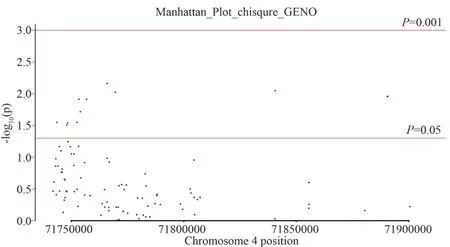
Fig 1 Manhattan plot of Chi square test based on codominant mode
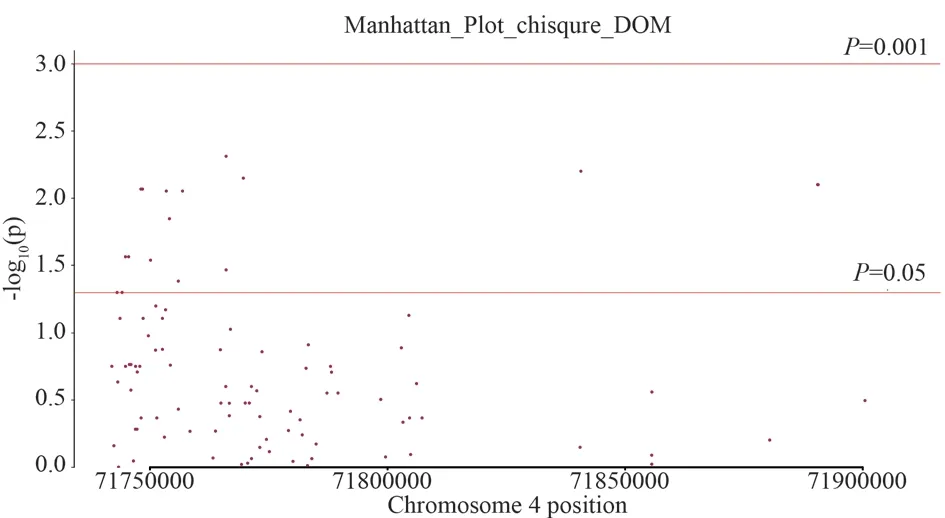
Fig 2 Manhattan plot of Chi square test based on dominant mode

Fig 3 Manhattan plot of Chi square test based on recessive mode
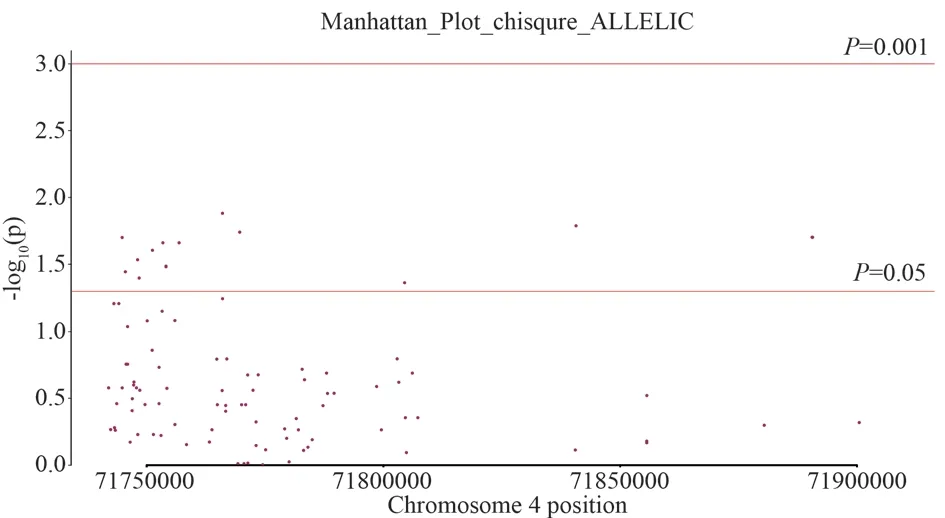
Fig 4 Manhattan plot of Chi square test based on allelic mode

Tab 1 Association analyses results of 21 SNPs with statistical differences (Chi square test)
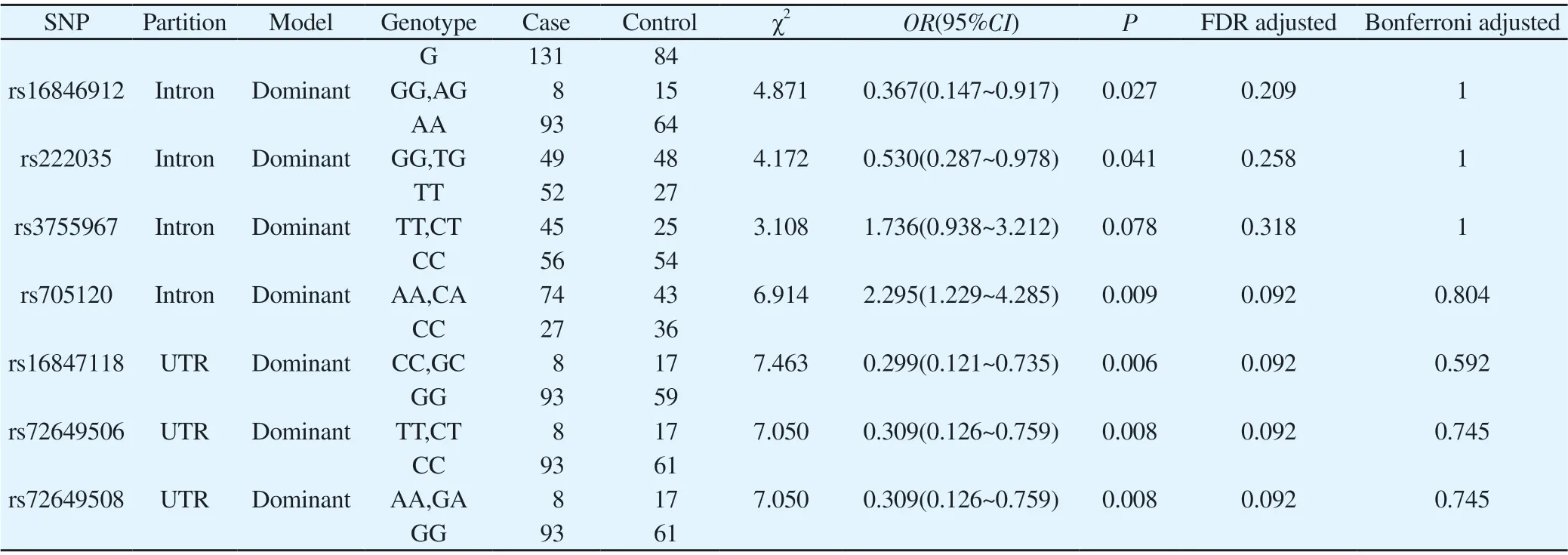
SNP Partition Model Genotype Case Control χ2 OR(95%CI) P FDR adjusted Bonferroni adjusted G 131 84 rs16846912 Intron Dominant GG,AG 8 15 4.871 0.367(0.147~0.917) 0.027 0.209 1 AA 93 64 rs222035 Intron Dominant GG,TG 49 48 4.172 0.530(0.287~0.978) 0.041 0.258 1 TT 52 27 rs3755967 Intron Dominant TT,CT 45 25 3.108 1.736(0.938~3.212) 0.078 0.318 1 CC 56 54 rs705120 Intron Dominant AA,CA 74 43 6.914 2.295(1.229~4.285) 0.009 0.092 0.804 CC 27 36 rs16847118 UTR Dominant CC,GC 8 17 7.463 0.299(0.121~0.735) 0.006 0.092 0.592 GG 93 59 rs72649506 UTR Dominant TT,CT 8 17 7.050 0.309(0.126~0.759) 0.008 0.092 0.745 CC 93 61 rs72649508 UTR Dominant AA,GA 8 17 7.050 0.309(0.126~0.759) 0.008 0.092 0.745 GG 93 61
3.2 Bioinformatics Analysis
The rs4588G>T in exon 11 is a non-synonymous mutation that causes the conversion of threonine to lysine (Thr→Lys) with a SIFT Score of 0.481 and a SIFT Score Pred of T. The rs4752A>G in exon 8 does not cause amino acid changes and is a synonymous mutation.
4. Discussion
The GC gene is transcribed, modified and translated to synthesize VDBP, which is distributed over three structural domains and consists of 458 amino acids. Scholars in different fields have agreed that GC genes are significantly associated with vitamin D levels and activity in vivo and are key genes for the synthesis of active vitamin D and its biological functions. This study aimed to explore the relationship between GC genes and psoriasis vulgaris at the level of SNP. SNPs can be located anywhere in a gene, where those located in exonic regions are called coding single nucleotide polymorphism (cSNP). cSNPs undergo variation in two forms. One is a synonymous mutation, in which the base is mutated but the translated amino acid is unchanged. Although the rs4752 identified in this study showed the A→G variant, it was still translated as cysteine (Cys) and did not cause altered gene function. Although bioinformatic analysis suggested that the amino acids translated at this locus were not altered, statistical analysis of the four different modes of inheritance in this study suggested that it was associated with psoriasis susceptibility in all three modes of inheritance:genotype, dominant and allelic (P=0.012, P=0.009, P=0.022). This may be related to the fact that synonymous mutations can affect the shear, stability, and structure of messenger RNA although they cannot cause amino acid changes[10]. The other type of mutation is a nonsynonymous mutation, where a SNP causes an amino acid change that is likely to lead to altered gene function. The rs4588G>T identified in this study was associated with psoriasis susceptibility in a genotype model(P=0.028)(Table 1), and bioinformatics analysis suggested that rs4588G>T mistranslates threonine to lysine.The previous work in this study suggested that the variation of this SNP would lead to the conversion of VDBP to GC2 type and a decreased affinity of GC2 to 25(OH)D3[12]. This suggests that, in terms of biological function, different isoforms of GC genes may affect the transmission of vitamin D-related signals at the tissue or cellular level. The bioinformatics analysis of this study suggested that this SNP had a SIFT Score of 0.481 and a SIFT Score Pred of T,which is a benign mutation. Although we did not find an association between rs4588 and psoriasis in our literature search, some findings suggest that in addition to a significant association with vitamin D levels in humans, it is associated with the development of colorectal cancer (OR=2.34, 95% CI=1.25-4.37) and an increased risk of developing type 2 diabetes (OR=8.9, 95% CI=1.89-41.99, P<0.001)All were correlated[5,6]. In addition, it has also been shown that rs4588 was only associated with basal values of serum vitamin D levels (P=7.86×10-7) and not with changes in serum vitamin D levels after vitamin D supplementation (P=0.15) [13].
The current study also identified 16 susceptibility SNPs located in the intronic region, 11 of which were not reported to have relevance to the disease (rs1565572, rs16845007, rs222009, rs222010,rs2276460, rs2282678, rs705121, rs73827381, rs73827381,rs7668653 and rs844806). rs73827382, rs7668653 and rs844806),and the remaining five SNPs (rs222040, rs16846912, rs222035,rs3755967 and rs705120) were correlated with other diseases or serum 25(OH)D3levels. A study from Norway involving 578 newborn mother-child (female) pairs showed that fetal rs222040 was the strongest correlated predictor of 25(OH)D3levels in neonatal cord blood (P<0.001). This study further confirmed that GC genes can be expressed in the placenta in addition to the liver, but whether VDBP in the mother and fetus is involved in placental vitamin D transport remains to be further verified[14]. The high correlation of rs222040 with basal serum 25(OH)D3values (P=1.59×10-4) was also shown in a study on the correlation between serum 25(OH)D3and vitamin D metabolic pathway genes involving 2207 Caucasian women[13].
A study from Shanghai with 3108 participants suggested that haplotype rs842999/rs705120/rs222040/rs4588/rs7041/rs10488854 GAGTAC was a risk factor for reduced 25(OH)D3levels (P=2.0×10-5), while low levels of 25(OH)D3were also associated with reduced VDBP levels were significantly associated.Accordingly, the investigators hypothesized that the variation in the GC gene causes a decrease in VDBP levels and thus serum 25(OH)D3levels, but they concluded that this result is unlikely to be caused by SNPs in the intron region of this haplotype (including rs222040)and that the nonsynonymous mutation rs4588 may be its potential pathogenic risk locus [15]. In addition, a correlation study on familial asthma and vitamin D metabolic signaling pathways showed that rs222040 was associated with elevated serum total IgE levels but not with vitamin D levels (PIgE=0.016, P25(OH)D3=0.382) [7]. This suggests that some of the variants identified in this study may also not directly affect the development of psoriasis vulgaris, but are simply marker loci with strong linkage disequilibrium (LD) between them and the true susceptibility loci for psoriasis vulgaris.
A 2010 paper in Lancet suggested that rs3755967 was significantly associated with low levels of 25(OH)D3in vivo (P=2.42×10-75)[16]. Further studies on rs3755967 have been conducted by several scholars since then. One of them, a study on the association of GC gene polymorphisms with 25(OH)D3levels in pregnant women and changes in 25(OH)D3levels after vitamin D supplementation in Zhoushan, Zhejiang Province, involving 2 658 pregnant women[17],showed that rs3755967 was associated with lower 25(OH)D3levels throughout the gestational cycle (P 0.000 1), and in early pregnancy after vitamin D supplementation After vitamin D supplementation in early pregnancy, the different genotypes (CT/TT) were significantly associated with a difference in rising 25(OH)D3levels in vivo (all P values < 0.000 1). This study also found that rs3755967 and rs7041 were highly LD (r2>0.96). Based on the results of this association analysis, the investigators concluded that it is the difference in affinity for vitamin D between the two non-synonymous mutations,rs4588 and rs7041, which are synthesized as different isoforms of VDBP, that causes the differential changes in 25(OH)D3levels during the gestational cycle and the rise in 25(OH)D3in vivo after vitamin D supplementation, rather than rs375596 on serum free 25(OH)D3levels had a direct effect. 1 GWAS study by a US team using phase I and II data from the Shanghai Breast Cancer Research Center showed no significant correlation between rs3755967 and breast cancer risk in Chinese women[18]. In contrast, in 1 stratified study from China on Chinese women with breast cancer suggested that CT genotype of rs3755967 was significantly associated with low risk of breast cancer (OR=0.77, 95% CI=0.62-0.96, P=0.021).Combined with previous epidemiological investigations, the team concluded that GC genes regulate cell proliferation and apoptosis by affecting active 25(OH)D3levels in vivo, and that in mammary cells, low levels of 25(OH)D3may modulate this effect by impairing enzyme activity and reducing 1,25(OH)2D3production. In addition,this study also found that rs17467825, rs2298850, rs3755967 and rs2282679 are highly interlocking imbalanced (r2=1.0, 0.9, 1.0), and combined with the relevant literature, they concluded that rs2282679 is associated with tumor risk, while rs3355967 is located in the intron region and may be involved in gene expression regulation or affect amino acid modifications. The exact cause needs to be further explored[8]. Another study showed that VDBP may also be directly involved in antitumor processes including chemotaxis and macrophage activation through non-vitamin D signaling pathways. This study suggested that VDBP is involved in activating macrophage molecules and forming VDBP-macrophage activating factor through glucosidase deglycosylation, which enhances the activity of pro-apoptotic enzymes and eventually induces apoptosis through JAK1/2 and p38 pathways to inhibit tumor development[19].An international study with 79366 participants confirmed that rs3755967 was significantly associated with reduced serum 25(OH)D3levels in European and North American populations (P=4.7×10-343) [20], a finding similar to that of a German study with 8417 elderly participants[21]. Another related study suggested that rs3755967 was significantly associated with low levels of serum 25(OH)D3in Arabs and South Asians, but not with serum 25(OH)D3levels in Southeast Asians [22]. This suggests that the biological effects of rs3355967 may not be the same among different races, and it is also possible that the results may differ due to the different living environments of the tested populations.
In addition, rs222035, rs222040 and rs705120 were shown to correlate with serum free 25(OH)D3levels, familial asthma and baseline serum 25(OH)D3levels, respectively, and rs7041, rs222035 and rs842999 were highly interlocking imbalances (r2>0.92)[7, 13, 23, 24].
Three SNPs located in the UTR (rs16847118, rs72649506,rs72649508) were also identified in this study, and after searching,none of them were reported to be associated with psoriasis, and further studies are needed.
In conclusion, this study reveals that there are 21 susceptibility SNPs associated with psoriasis vulgaris in a Han Chinese population of Hainan origin, located in introns, exons and UTRs of the GC gene, where SNPs on exons can lead to protein alterations and have a greater potential to affect gene function. This suggests that there is an association between the GC gene and susceptibility to psoriasis vulgaris, but due to the small sample size of this study, it remains to be explored on a larger scale in a larger sample size and/or other populations, and then confirmed by functional studies.
Author’s contribution
Liu Kun, tied for first authorship, was responsible for case specimen collection, experimental operation and writing the first draft of the paper; Liu Jun-Lin, tied for first author, is responsible for study design, article writing guidance and revisions, Yuan Cheng-da is responsible for data processing and article revision;Lu Chun-Wan, co-corresponding author, is responsible for case and control specimen collection and experimental operation. Yin Mei, corresponding author, was responsible for control specimen collection, literature search and article content review.
All authors declare no conflict of interest.
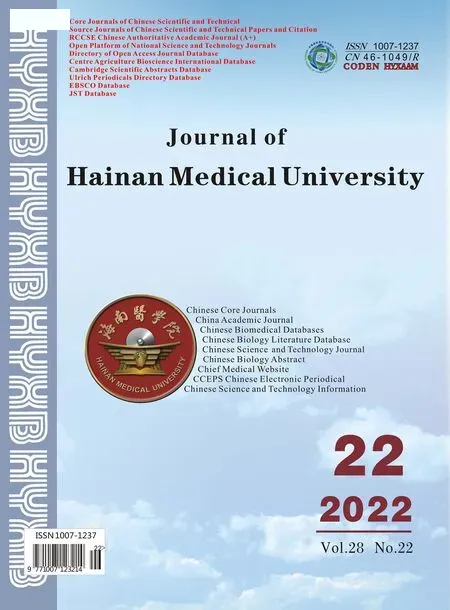 Journal of Hainan Medical College2022年22期
Journal of Hainan Medical College2022年22期
- Journal of Hainan Medical College的其它文章
- Research advances in functional heartburn based on Rome Ⅳ criteria
- Research progress on modern pharmacological action of Radix bupleuri
- Tanreqing injection auxiliary in the treatment of heart failure with pulmonary infection: A systematic review
- Mechanism of total flavonoids in the treatment of rheumatoid arthritis based on network pharmacology
- Clinical characteristics of 72 cases with neuromyelitis optical associated optic neuritis
- Application of SOAT1 combined with multiple markers in the auxiliary diagnosis of hepatocellular carcinoma
